this is part two of temple architecture and sculpture. There exists a combination of spirituality and artistry in Indian temple architecture and sculpture. Temples are normally identified with tall spires, known as shikharas or vimanas, and refined engravings. Beehive-shaped spires are common in North India while pyramidal structures characterize South Indian temples.
These sculptures cover walls, pillars and doorways of the buildings showing gods, goddesses, mythical beings from Hindu literature like Mahabharata or Ramayana. The style is characterized by large gopurams connected to the gateway towers made of stone that gives the architecture a unique look.
Nagara style puts prominence on complex carvings together with sculptural niches in its architectural designs. Collectively these elements create a divine atmosphere which is peaceful reflecting upon India’s cultural legacies having developed over thousands of years
Chola Temple architecture and sculpture
Special importance on Sculpture in the declaration of chola temples. It was an important feature of chola temples. An important example of chola Sculpture the was the Sculpture of Nataraja in dancing posture. The Ravana hill sculpture of Aihole shows the idol of Nataraja was made even during the Chalukya rule. This art reached its peak during the chola rule.

The main features of idol are–
There is a drum in the upper right hand which symbolizes the sound of creation. All the creation of the world has been created by the great sound of Damrau. in the upper left hands internal fire, symbolizing distraction. Distraction is the precursor to creation and the invertible.
The lower right hand is raised in Abhaya mudra Which represents a blessing and assures a sense of fearlessness and devotees. The lower left-hand points towards the raised foot and represents the path to salvation. Shiva is performing the Tandava dance on top of a small dwarf figure. That dwarfs symbolize ignorance and the arrogance of an ignorant person. Shiva’s matted and flowing looks in the wind symbolize the flow of the river Ganga.
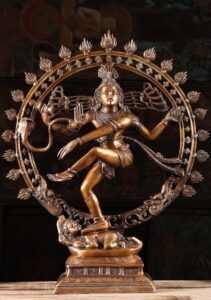
Shiva Has a man’s earring in one ear while a woman’s earring is in the other, it symbolizes the modesty of men and women, and it is often referred to as adha -nuarishvara .a snake Each wrapped around Shiva’s arm. The symbolizes the kundalini shakti, which is in the human spine.
If this power is awakened, then man can achieve true consciousness. The Nataraja posture of Shiva is surrounded by a halo of light which symbolizes the vast. Endless cycle of time.
Other styles of temple architecture and sculpture
Vijayanagar style
The rulers of Vijayanagar Empire [1335-1565]. Whose capital was Hampi, [Karnataka]were great patrons of art and architecture. combined the features of chola, Hoysala, Pandya, Chalukya architecture styles. under him, the architectural style began to be influenced by the indo – Islamic style over Bijapur, which is reflected in the temples built during this period
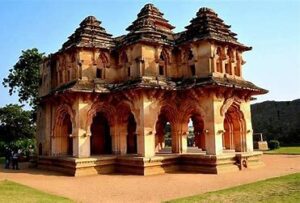
features of these temple architecture and sculpture
The walls of the temple are highly decorated with carvings and geometric patterns, which were earlier on the front, now started being built in all directions. Monolithic stone pillar. Generally, the mycological Creature Yali was engraved on the pillars of the temple. The enclosing walls were large. More than one pavilion was built in each temple. This central pavilion came to be known as the Kalyana Mandapam. The concept of secular buildings within the temple complex also became prevalent during this period.
The temple architecture and sculpture complex were surrounded by a boundary wall. example: Vittala swami temple at Hampi,etc. .The statue of Narasimha on Shesh Carved out of rope near a Hampi is a miracle in itself.
Nayak Style of temple architecture and sculpture
The Nayak Style of Temple architecture developed under the Nayak Style between the 6th century to the 18th century AD. It is also known as Madurai style. It is similar to the Dravidian style from the architectural point of view, but it is much a border. It also has Islamic influence.
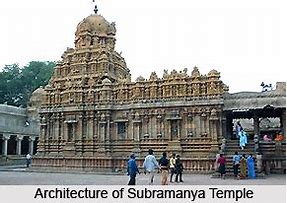
Some unique features are temple architecture and sculpture
Along with the Verandah construction of a large corridor around the sanctum sanctorum. Called Prakrama and construction of a roofed circumambulation path along it. The gopurams built by the Nayak rulers were among the largest. The gopuram of Meena temple in Madurai is the tallest gopuram in the world. The gopuram reached its zenith in the Nayak style. There were intricate carvings everywhere on the temple. example: Minakshi temple of Madurai, etc.
Weser style of temple architecture and sculpture
The construction of this temple was conceived under the Chalukya rulers in the middle of the 7th century AD. This style is also called Karnataka style. It is a hybrid style. It combines features of both nagara and Dravidian style.
Some of the features are temple architecture and sculpture
More important to the plane and the pavilion, open circumambulation, path, the pillars, doors and ceiling. Decorated with the intricate carvings.
The three major dynasties that built temples in the Vesara style are: Chalukya of Badami and Kalyani. Rashtra Kuta {750-983 AD}
Example: -Kailash temple at Ellora etc.
Hoysala dynasty {1050-1300 AD} for example, temples at hale bid, bluer etc.
The influence of nagara style is visible in the curved Peak Square base of the Vesara temple. The influence of the Dravidian style is visible in the intricate carving and sculpture. vimana design and stepped spires of the Vesara temple. example: Dodubasapp, temple of Dambal,ladkhan temple of Aihole,temple of Badami etc.
Hoysala art of temple architecture and sculpture
In the Karnataka region Temples built under the. Holesala rulers developed their own distinctive style, known as the royal style Hoysala style of art. It flourished in major sites like Belur, Halebidu and Srinagar during the period.
Features of this temple architecture and sculpture
Several temples were built around a pillared central hall. Unlike the crucified ground plan of punchayet style, this temple was built in the shape of a star with intricate design. It is also known as the stettate plan, the main building material was sandstone
A lot of emphasis was given to the ornaments and of the temple through sculpture, both the internal and external walls, even the ornaments worn by the deities, were intricately carved. There were pinnacles on the chambers which were connected to each other by a configuration of horizontal lines and stripes. it divided the peak into an orderly sequence of rows. The temple was built on a raised platform known as Jagati. Its height was about one matter. The walls and stairs of the temple were in a zig-zag pattern.
Pala and Sen style of temple architecture and sculpture
In the Bengal region, the style of architecture came to be known as the pala and Sen architecture styles. Pala and Sen of architecture the Palas were predominantly Buddhist rulers who followed the Mahayana tradition, but we’re very tolerant and patronized both religions.
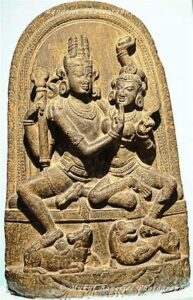
Pala Kings built many viharas, chaityas and stupas. Sen was a Hindu deity and also maintained Buddhist architecture. Thus, this architecture reflects the influence of both these religions.
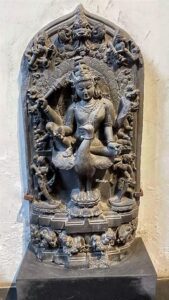
The monuments under Pala rulers of temple architecture and sculpture
The University of Nalanda, Jagaddal, Odantapuri and Vikram Shila developed under the pala rules some Sompura Mahavira in Bangladesh is a grand. Monastery developed by him.
Monuments under Sen rulers of temple architecture and sculpture
Dhaneshwari temple Bangladesh is characteristic of architecture. Under the Sen rulers, baked bricks and clay, called terracotta bricks, were the main building materials used.
The temple architecture and sculpture of this region is characterized by a bamboo hut-like building with carved or sloping roofs. It is popularly known as the “Bangalore roofs” and was later adopted by Mughal architecture.
The temple architecture and sculpture of this region had a tall Curved shikhara topped with a huge Orissa style Amalka. For the sculpture of this region, both stone and metals were used; stone was the main component. These sculptures were unique due to their highly polished finishing. Example Sidheshwar Mahadeva temple in Barakar, temple around vishnupur etc.
Angkor Wat temple, Cambodia of temple architecture and sculpture
Angkor wat world’s largest is located in the jungle of Cambodia. This is just one of many Hindu temples in Southeast Asia. God: Vishnu
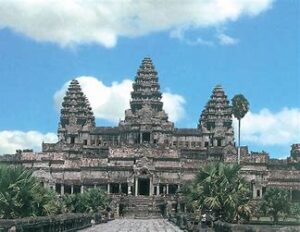
Hinduism came to these parts with the maritime activities of the chola empire, Kling empire etc. And the rise of many Hindu dynasties, such as the Champa civilization in Vietnam, the Khmer empire in Cambodia and the Majapahit empire in Java. The Angkor group of temples was built by the Khmer rulers between (800-1300) Suryavarman 2nd, credited with the construction of most of these monuments; their architecture has a very close relation with chola architecture, but it has also had some distinct glimpse, of local style.
Prambanan emple architecture and sculpture, java-Indonesia
A UNESCO World Heritage Site and the largest Hindu temple in Indonesia. It is dedicated to the group of gods Called 3 Trimurti, namely Brahma, Vishnu. And Silva, there are 240 small temples and. Monasteries in its complex. It was built in the 9th century AD by the Sanjay Rural of the Matram or Madang kingdom who were mainly worshippers of shiva.
Pasupati Nath temple, Kathmandu. (Nepal). This temple on the banks of the Bagmati River is built in the Nepalese pagoda style of architecture. It is dedicated to lord of Pashupati Nath or shiva. Its shape is cubic, and it is two storeyed. It has Sanctum-inner and outer. The inner sanctum has a four faced Shivalinga. The temple complex also houses the Vasuki Nath temple sacred Arya ghat. who built this temple.
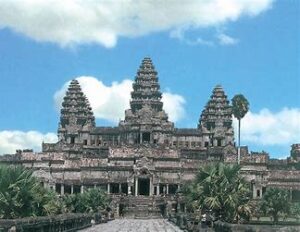
Conclusion:
The reflecting Temple architecture and sculpture, style and sculpture show the depth of Indian culture. The styles of Gupta temples at the beginning to those grand ones in this modern day had their own peculiarities. Nagar, Dravidian, and Weser are major styles. The sculptures of these temples depicted religious stories and also portrayed the life of gods in a very artistic way. Temple architecture has unique designs, convoluted carvings and is full of religious symbols. Such temple art of temples is not only religious but also forms part of cultural and historical heritage.
